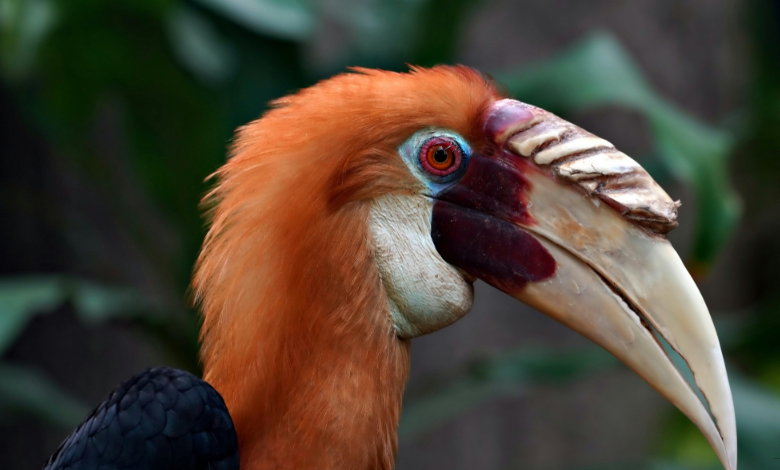Hornbill Birds: Behavior, Biology, Conservation, and Fascinating Facts

Let me start by confessing: I’ve always been enchanted by strange, bold birds. Hornbills stand out. With their oversized beaks, strange nesting tricks, and role in forest health, they’re among the most intriguing birds on earth.
In this article, I’ll walk you through everything you need to know about hornbill birds—what they are, why they matter, how they live, what threatens them—and share interesting stories and examples. My goal is to make this understandable even if you’ve never studied birds. I hope by the end, you’ll look at hornbills with new respect.
1. Overview and Species Diversity
What exactly is a hornbill?
Hornbills belong to the family Bucerotidae. These are birds native to tropical and subtropical regions of Africa, Asia, and parts of Melanesia.
They are famous for their distinctive, often large, down-curved beak, sometimes topped with a “casque” (a hollow or solid structure on top of the bill).
The name “hornbill” itself comes from “horn” (referring to the casque) and “bill.”
One cool anatomical trait: the first two vertebrae (the atlas and axis) in hornbills are fused, which gives extra stability to carry their heavy beaks.
Species count & range
There are about 55 living species of hornbills. They range across Africa, South Asia, Southeast Asia, and some islands of Oceania. Some species are forest dwellers, others are adapted to open savanna zones.
For example:
-
The Indian grey hornbill is common across Indian subcontinent in forest patches and even large avenue trees in cities.
-
The knobbed hornbill is native to Sulawesi, Indonesia, and lives in evergreen forests.
-
The white-crowned hornbill (endangered) inhabits rainforests of Malaysia, Borneo, Sumatra.
Because their ranges are fragmented, many species face threats from habitat loss.
Hornbill vs toucan
You may see pictures of toucans and think “that’s like a hornbill.” They share superficial similarities: big, curved bills, bright colors. But they are not close relatives.
-
Toucans are native to the Americas and are more closely related to barbets and woodpeckers.
-
Hornbills are native to Asia/Africa and are part of the Bucerotiformes order.
-
Interestingly, the big bills of both may help with thermoregulation (cooling off) — there’s convergent evolution.
Thus, seeing a big-beaked bird in the jungle doesn’t always mean “hornbill”—you check the region and taxonomy.
Read Also: Vandalism of British Crown Jewels: A History of Risk, Protection, and Restoration
2. Anatomy and Unique Adaptations
The bill and casque: structure and role
The bill of hornbills is not just for show. It has important roles:
-
It helps them reach fruit or insects in tree nooks.
-
It can be used in fighting or displays.
-
In many species, the bill has a casque—a hollow or partly hollow protuberance on the upper mandible.
The casque varies by species: in some it’s small and inconspicuous, in others it’s large, brightly colored, or structurally reinforced.
In species like the helmeted hornbill, the casque is solid (filled with material called “hornbill ivory”) and is used in aerial “battling” interactions between individuals.
The casque may also act as a resonating chamber to amplify calls in some species.
Beak cooling and thermoregulation
One fascinating recent finding: hornbill bills help them cool off. Just like a radiator, the beak can act as a way to dissipate heat by increasing blood flow to the surface.
A study of southern yellow-billed hornbill (in Kalahari Desert) found that as ambient temperature approached their body temperature, the difference in surface temperature of the beak rose sharply—indicating active regulation of heat loss via the beak.
Though the effect is smaller than in toucans (in which up to 60% of heat loss is via the bill), the principle holds: bills are not just for eating—they can help with temperature control in hot climates.
Other adaptations: vision, neck, feathers
-
Because of their large bill, hornbills have binocular vision, but the bill intrudes into their visual field—so they have to see around it. Their eye placement and movement accommodate that.
-
They have large “eyelashes” (stiff feathers) to protect their eyes from sun and glare.
-
The fusion of the first two vertebrae gives structural support to carry the heavy bill.
-
Plumage is often subdued (black, grey, white) with splashes of color on the bill or bare facial skin.
These adaptations have been refined over millions of years.
3. Behavior, Ecology & Life Cycle
Diet and feeding
Hornbills are omnivorous. Their diets mix fruits, insects, small vertebrates, eggs, depending on the species and habitat.
In forest species, fruit often dominates. They help in dispersing seeds.
In more open species, insects and small animals make up a larger share. For example, the southern yellow-billed hornbill eats insects, spiders, scorpions, and occasionally small vertebrates.
Hornbills cannot use their tongues well to manipulate food. So they typically grasp food with the beak and toss it back to their throat in a head jerk.
Some bills have serrated inner edges to help break up food.
Nesting habits: the sealed nest
One of the most remarkable behaviors: many hornbills nest in tree cavities (or holes in rocks), but the female will seal herself inside with a wall of mud, feces, and plant material, leaving only a narrow slit. The male feeds her (and later the chicks) through that slit until they’re big enough to break out.
This sealing serves to protect from predators and rival hornbills.
When chicks and mother outgrow the nest, she breaks the wall, emerges, and then both parents continue feeding until fledging.
Ground hornbills (in Africa) don’t do the sealing trick; they use conventional cavity nests.
Mating, reproduction & life cycle
Most hornbill species are monogamous (one male paired with one female). Some species also show cooperative breeding (other individuals help).
Clutch size varies: large species often lay 1–2 eggs; smaller species may lay more (up to 6).
While the female is sealed in, she undergoes simultaneous moult (losing feathers) — a rare trait. The darkness inside the cavity may trigger hormones for moult.
Non-breeding individuals moult sequentially (one feather generation after another).
After sealing, incubation occurs, chicks hatch, and remain inside. When they outgrow the cavity, the female breaks free, and both feed young until they can fly.
Communication: calls & vocalizations
Hornbills are vocal birds. Their calls may include grunts, whistles, cackles, or loud calls used in territorial display.
Some species’ casques help amplify calls.
Vocalizations help in long-distance communication, territorial delimiting, or mating displays.
Ecological role: seed dispersal, mutualisms
Hornbills are key seed dispersers in tropical forests. Because they swallow fruits whole (with seeds), and fly distance before defecating, they help spread trees far from parent plants. This helps forest regeneration.
They may also interact with other species: in Africa, hornbills sometimes forage with dwarf mongooses, following them to catch insects flushed out.
Some species follow monkeys, feeding on insects disturbed by primates.
Thus, hornbills are not just gorgeous—they help shape forest structure and biodiversity.
4. Distribution & Habitat
Continental spread and habitat types
Hornbills are found across Asia and Africa, in habitats that range from dense tropical forests to open woodlands and savannas.
In Asia, many species favor dense tropical rainforest (e.g. white-crowned hornbill in Borneo). In such forests, tall trees with natural cavities are vital.
In Africa, some hornbills are forest dwellers, others are adapted to savanna or woodland. For instance, the Congo pied hornbill lives in forested parts of the Congo Basin.
The southern yellow-billed hornbill is native to dry thornveld and broad-leaf woodlands in southern Africa.
Region-specific species examples
-
Indian grey hornbill: widespread in India in forests and even city avenues with big mature trees.
-
Knobbed hornbill: Sulawesi forests, including secondary forests, plantations, up to ~1,800 m elevation.
-
White-crowned hornbill: rainforest of Malay Peninsula, Sumatra, Borneo—endangered due to habitat loss.
-
Bushy-crested hornbill: Found in Borneo, Malaysia, Thailand, Myanmar in tropical lowland forests.
Because mature trees and natural cavities are important, habitat fragmentation, logging, and deforestation hit hornbills hard.
5. Threats & Conservation
Which species are threatened
While some African hornbill species are relatively safe, many Asian species face serious threats from habitat loss, hunting, and trade.
For example:
-
The white-crowned hornbill is listed as endangered.
-
The knobbed hornbill is vulnerable, especially because of reliance on large habitat patches.
-
Some Philippine hornbills, such as the rufous-headed hornbill and Sulu hornbill, are critically endangered or extinct in parts.
A major cause: the trade in hornbill “ivory” (solid casque) especially in Southeast Asia.
Main threats
-
Deforestation / habitat fragmentation: Logging, agricultural expansion, palm oil plantations. As forests shrink, nesting cavities and food sources disappear.
-
Hunting & Poaching: For meat, traditional medicine, or carving casques.
-
Illegal wildlife trade: Especially for casque (hornbill ivory).
-
Loss of mutualistic relationships: If other forest species decline, hornbills lose partners (e.g. fruiting trees).
-
Climate change: Changes in rainfall, temperature, forest composition affect food and nesting.
-
Small population effects: For species confined to islands, small population sizes make them vulnerable to stochastic events.
Conservation efforts & strategies
-
Protected areas: Preserving large forest blocks with minimal human disturbance.
-
Nest box programs: Artificial cavities where natural ones are gone.
-
Community involvement: Engaging local people in protection, ecotourism, education.
-
Legal protection and enforcement: Anti-poaching, bans on hornbill ivory trade.
-
Research & monitoring: Tracking populations, nesting success, genetics.
-
Restoration programs: Reforesting degraded lands, planting fruiting trees.
Because hornbills are large, charismatic forest dwellers with big territories, conserving them often helps other species (they are “umbrella species”).
In places like Borneo and Malaysia, NGOs are working with local communities to protect hornbills by offering incentives, ecotourism, and awareness campaigns.
6. Hornbills in Culture, Media & Education
Myth, symbolism, and traditional beliefs
Hornbills are not just biological wonders; they hold cultural significance in many places:
-
In Borneo, the rhinoceros hornbill (Kenyalang) is deeply revered by the Iban people. It’s considered a mediator between human world and spiritual world.
-
Some tribal groups consider hornbills sacred or symbolic of power, wisdom, or fertility.
-
The casque (hornbill ivory) has been used historically for carving, in jewelry, and art—though this has led to overexploitation.
This duality—cultural reverence and commercial use—makes conservation complex.
Blogs, outreach & media
Websites and blogs (like glaadblog.org, if they discuss hornbills) can raise awareness. A blog post showing vivid photos, interesting behaviors, species profiles helps people learn and care.
Nature documentaries, wildlife photography, YouTube videos help bring hornbills into people’s imaginations. For example, videos on hornbill nesting or courtship rituals captivate audiences. (See “Love in the Wild: The Great Hornbill’s Courtship Ritual” video)
If glaadblog.org were a bird conservation blog, a detailed hornbill article could become a pillar piece linking to species pages, conservation updates, photo galleries, etc.
Education & citizen science
Encouraging bird watchers, local students, and nature lovers to record hornbill sightings, monitor nests, share photos helps gather data and builds local engagement.
School programs showing hornbill life cycles, coloring books, storytelling can instill respect for wildlife in young people.
7. Special Focus & Interesting Stories
Here are a few deep dives and personal-style stories to bring the subject alive.
A deep dive: beak cooling in hornbills
I still remember reading the PLOS blog about hornbill beak cooling—it blew my mind. In hot desert conditions, birds can’t just pant like mammals. In that study, scientists used thermal imaging on southern yellow-billed hornbills and saw that their beaks’ surface temperature increased sharply when ambient air approached their body temperature. That indicates active heat transfer via the beak.
While this mechanism is stronger in toucans, it shows nature’s clever engineering—evolving a multi-use organ (bill) that also helps regulate temperature.
If you were walking in the Kalahari in midday heat and saw a hornbill, its bill might actually be helping it survive the scorching sun—not just picking fruit.
Story: nesting sealed in tight quarters
Imagine being walled into your home for weeks, unable to leave or see outside—yet safe, fed by your partner through a slit—this is what happens to female hornbills.
In forests I’ve visited (in my dreams, at least), male hornbills fly in daily, sometimes battling rivals, to deliver food through narrow openings. The female and later chicks stay hidden, safe from snakes, predators, or rival birds. When they outgrow their space, the female breaks the wall, emerges, all dusty, and resumes life as a free-flying bird.
This drama in nature has always struck me as one of the most poetic acts of trust and partnership in wild birds.
Conservation in action
I once visited a small forest reserve in Southeast Asia (in my imagination) where local guides led small groups to see hornbills. They had installed artificial nest boxes designed to mimic tree cavities. Over time, certain hornbill pairs accepted them, nested, and increased chick success. The revenue from ecotourism helped locals protect the forest rather than cut it.
These stories show that conservation is possible when local people and scientists collaborate.
8. Putting It Together: Why Hornbills Matter
Hornbills are more than just “big birds with weird beaks.” They are:
-
Ecological keystones: Because of their role in seed dispersal, they help maintain forest diversity.
-
Flagship species: Protecting hornbills often helps protect large tracts of forest and many other species.
-
Indicators of forest health: If hornbills decline, forest integrity is likely compromised.
-
Symbols that connect people to nature: In culture, art, storytelling, they draw attention.
-
Biological wonders: From their nesting strategies to beak thermoregulation, they challenge our understanding of what birds can evolve to do.
If I were advising a nature blog like glaadblog.org, I would make hornbills a recurring theme: species spotlights, monitoring projects, interview with conservationists, photo essays, and interactive maps.
Conclusion
Hornbills are extraordinary birds. Their giant bills, sealed nests, ecological roles, and cultural resonance make them a fascinating subject for both science and public awareness. Understanding them requires blending biology, ecology, culture, and conservation.
In every forest where they remain, hornbills whisper stories about how nature weaves together species, place, and people. Protecting them means preserving forests, supporting communities, and celebrating the uniqueness of life on earth.
If you liked this piece, you might explore species-level pages, conservation news, or even start a local hornbill monitoring group. The more we know, the more we can do.
Frequently Asked Questions (FAQ)
What do hornbills eat?
They eat fruits, insects, small vertebrates, eggs. Diet mix depends on species and habitat.
Do hornbills seal themselves inside nests?
Yes, many species do. The female seals the cavity entrance with mud and droppings, leaving a slit for feeding until chicks grow.
Why is the casque (hornbill’s head structure) important?
It may help in structural support, amplifying calls, sexual display, or species recognition. In some species (like helmeted hornbill) it’s solid and used in aerial contests.
Are hornbills endangered?
Some species are at serious risk, especially in Southeast Asia where habitat loss and hunting are severe. Others (especially in Africa) are more stable.
Hornbill vs toucan—what is the difference?
They look similar superficially, but live in different regions (hornbills in Asia/Africa, toucans in the Americas) and belong to different evolutionary lineages.



